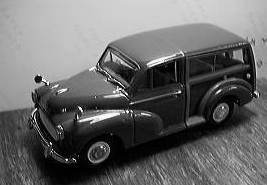
A toy one.

A toy one.
I learnt on my mother's 1963 Mini (989 YKJ) and a driving school car of a then almost unknown make - a Datsun 1200. After I passed the test, I had the use of the Mini until it was replaced by a red 1964 Austin 1100 (DPF 628B). Having decided to buy something of my own to take to university, I set out to look for a van, maybe a Minivan or an old A35 van. I ended up with this moggie Traveller, which was similar but looked better and had more room, though it was more expensive. It came minus a passenger seat, though one was easily found, but more worrying was that the engine boiled after only a short run. I think I was done, and the seller switched engines on me between sale and collection (he had a well-equipped garage and lots of old parts around), though I didn't argue as another engine was found for a fiver. With this fitted, the car did me for nearly three years, the longest I've used the same car, until the MX-5.
It failed every MoT through rust and brake problems, but it was fixable each year. The handbrake would work for a few weeks, then disappear, so in hilly Bristol it was essential to leave it in gear, and learn which way to point the wheels to the kerb for uphill and downhill parking. The footbrake barely held it when you had to stop at the junction half-way down St Michael's Hill. The floor was part original, and part old oilcans flattened out and pop-rivetted over the holes. Special pins had to be made to hold the windows up, as the winders were tired, and part of the trim in the back was retained by bits of Meccano.
The front torsion bar suspension had sagged and to compensate someone had removed the rubber bump-stops to get more clear movement. This was OK until the suspension bottomed out on a pothole, then the metal-on-metal impact sounded as if the front had fallen off. It had a proper starting handle which I used when the battery was failing and I wasn't able to park it facing downhill. It also had red flashers at the back using the same filaments as the brakelights with a relay box to switch functions; if you braked while indicating only the brake light on the opposite side would work.
The car came with a duplicate log book (a folding handwritten card in those days) with the year of manufacture missing. That it was probably a 1961 was deduced from flapping-arm trafficators being replaced in 1961, the 1098cc engine being used from 1962 and orange flashers appearing in 1963.
This is the car I had through the oil crisis of 1973..1974. I was issued with petrol rationing coupons in November 1973, which looked like this and this.
The entire wiring diagram wiring diagram fitted easily on one page in the Haynes book.
A car with character, and a history.
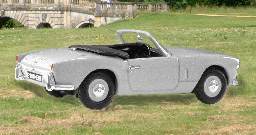
A faked picture using a model.
Memories. Breezing up to the Four Horseshoes on a summer's evening, running back again late at night, roof off but still waving a hand into the breeze to cool off. The summer of 1976 was hot, and I recall not having the roof on for three or four months. Of course, it would rain a little now and then, but I had a full tonneau to keep the inside dry, and I would drive it in the rain with only the driver's side unzipped. You don't get very wet if you can keep moving!
The downside was that the car was ten years old, and needed a lot of attention. I became familiar with most of its innards, its lovely four into two into one exhaust manifold, the twin SUs, the trunnions supporting the outer ends of the swing-axles at the rear, the simple round instruments and central flat panel dash. It was treacherous to drive if pushed hard, you were likely to end up facing the wrong way; though, as compensation, the swing-axle suspension seemed to promote impressive tyre squeal on cornering even at moderately safe speeds.
It met its end as an MoT failure, with rust in body and chassis. I suppose I should have kept it and restored it, but I didn't, I sold it to someone who claimed he wanted it for parts, but actually fixed it and ran it again.
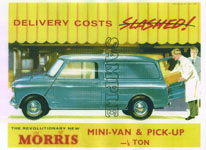
A stolen pic, from an ad.
A forced purchase, to get me to work as the Spitfire was off the road. A "friend" sold it to me, forgetting to tell me that there was a hole in the petrol tank. "I didn't know - I could never afford to fill the tank more than half-full" he said (the tank on an old minivan held about six UK gallons). It had folding seats in the back, and galloping rust. One of the headlights fell out while I was investigating why it was working intermittently (all the metal forming the body return had gone), and on another occasion I was sitting on its bonnet, kicking my heels against its side, until someone pointed out that with every kick some of the sill was falling away.
Despite this, I sold it to a colleague at work (at 99960 miles) who ran it for another 20000 miles.
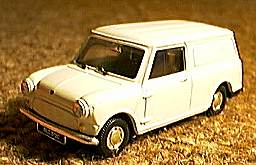
A model painted white to look like mine.
Ah, I thought, if I could cope with a 10-year-old minivan, then I could buy a new one and run it for 10 years, at a depreciation cost of only 200 pounds/year, and be no worse off. So I had it Ziebarted against rust. Only it didn't work. Newness becomes addictive, and anyway, I had become used to change. I lasted only two years.
This was a good car, and it drove well, as can be deduced from my getting through a set of front tyres in 10000 miles. Front wheel drive, and a light back end, made fast cornering easy, and, because it weighed so little, it went well even on its tiny engine.
Good, cheap, versatile transport; though an unusual vehicle to buy new for private use. It easily beat 50mi/UKgall on a trip.
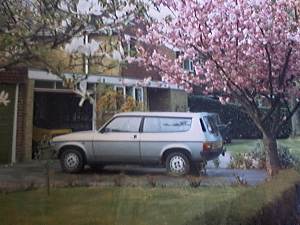
Outside the parents' house.
A much maligned car, probably deservedly, though by the time this one was made (series 3) it had become a useful, reliable but boring car. The square steering wheel ("Quartic" they called it) had long gone. Nevertheless, I like the shape of the estate, and it looked smart with its silver paint and black trim stripe. The first real car I had, so the decent trim and equipment, and cloth-covered seats, seemed luxurious. The 1.5-litre twin-SU engine made it reasonably quick, and it had 5 speeds long before this became the norm.
However, on its first Sunday, it started to splutter and pour petrol onto the road. As I needed the car, and I was still in fix-it mode, I dismantled the carburettors and discovered a piece of brass swarf jamming one of the needle valves open. Also, both window winders broke in the first year, and the windscreen leaked (until it shattered and was replaced). So maybe not so good.

With Joan Merrall leaning on it outside a pub.
Was it me that parked it like that??
There was a short gap between this one and the last, filled partly by borrowing Janet's P-reg red Mini, and partly by hiring a VW Golf. The Metro was supposed to be ready for August 1st, but it didn't arrive until the 11th.
Great fun, not very fast but agile. This was the first in the modern series of BL using the MG badge on pretty standard cars, and attracted some interest at the time, though apart from the red seat belts and fancy decals, the only difference from the ordinary 1.3 Metro was an extra 12 horsepower from the higher-compression engine.
The brakes were too small. They would overheat, smell, make noises and stop working after about the third stop from 120km/h, and with the roundabouts on the Milton Keynes grid roads spaced about every 800m they got into this state quite often. My best effort was to get through a set of pads in just over 8000 km. Later models had larger ventilated disks. Tyres didn't last me long either.
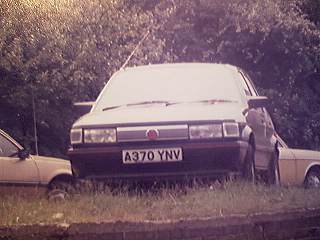
Even my photos of it have gone wrong.
A bad buy. Value dropped like a stone, things went wrong, awful torque-steer and scrabbling, electronic instruments went haywire. For some reason, this car had an S-series engine, despite the early ones having a different R-series engine, and later ones having a 2-litre injected O-series engine. They made this version from April to September 1984; there were only ever 2722 of them. The carburettors were in a block almost as big as the head, squashed up at the back of the engine and cooled by a special electric fan via a long duct. This fan ran on for a few minutes after the engine was stopped. After this time the carbs would get hot, and the car would be a pig to start, and a pig to drive, until some air got to the carbs. It was also difficult to start from cold, and would splutter and stall if stuck in a jam. The voice synthesiser would announce that the engine was too hot first thing on a damp winter morning. The engine would misfire and lose power in any sort of motorway spray. I think the BL engineers came back from a good pub session one Friday afternoon and designed this car as a joke.
Not sorry to see this one go, nor to see the last of British Leyland/BL/Austin Rover as well.

Outside the old flat.
Naturally, after a car that didn't run well cold, or hot, or in the wet, a car that ran perfectly smoothly in all conditions - a diesel. Also by comparison a very slow car, but a very comfortable one, with self-levelling hydropneumatic suspension. Also an individual car, in styling and engineering, with finger-tip clusters of controls rather than stalks, drum speedometer, single wiper, handbrake on the front wheels and power disk brakes all round. (These were not merely servo-assisted, there was no master cylinder and the pedal hardly moved, it just operated a spool valve to let hydraulic fluid from the main reservoir into the brakes - no engine, eventually no brakes at all apart from the special handbrake. The same pump seemed to supply the power steering, the brakes and the suspension, with a separate reservoir for the brakes; there was a big, red warning sign on the dashboard saying "STOP" if the hydraulic pressure or level fell.)
Very comfortable, practical and economical, averaging 5.8 l/100km.

Why didn't I wash it before taking its picture?
A little rocket, 85 horsepower and 720 kilograms.
And that's about it really. The AX was quite pretty, especially the GT without the half-hidden rear wheels, but was an early victim of the modern trend for providing clever storage for cups, bottles, &c rather than just space for the sorts of things I want to keep. Minor controls were naff. But basically, it was that light flimsy body allied with that light but tuned-up 1.4 engine.
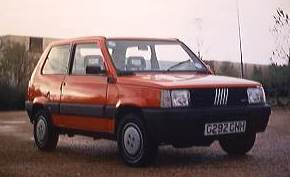
Brand new.
A change of mood. Not only was my driving of the AX getting a bit hairy (it was fast and tempting, but it had limits), but I was on an economy kick, hence a car that could be bought out of the proceeds of the private sale of the AX. The Panda was interesting from a production engineering point of view. The use of all flat glass, with left and right sides being the same part, without spoiling the looks was ingenious. So was the washer bottle that also served to retain the spare wheel (over the engine) and hold the small parts of the tool kit, and was itself held by a single, vertical, self-tapping screw. Someone thought about that.
The engine was good, and the inside cheerful, if not the peak of comfort. There was more storage space than in many big cars.
Unfortunately, just as I was getting settled into it, I got promoted and became eligible for a company car. As the cash alternative was only about 2700 GBP/annum it made no sense to keep the Panda, so the poor thing was sold off early.

The front looks worse.
Typical fill-in company car. OK, but no regrets when it went, except that the next one was worse. At least someone else was paying.
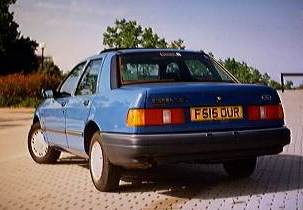
The offending boot.
The most horrible car imaginable. Slow, badly-equipped, ugly and masses of boot sticking out of the back that you couldn't see. Awful. Even when someone else was paying.

Another crap photo.
The least boring choice from a list of very boring cars. Also, the most powerful and best-equipped on the list that came in under the (then) tax threshold of 1400 cc. The alternator failed, and it took the Rover dealer two days to fix it. Also brake pads wore to metal shortly after a service. 1400 K-series engine was generally good, but gutless at low revs, so it was difficult to drive quickly and quietly. Comfort was appreciated on a trip from Milton Keynes to Inverness, but it was surprisingly noisy, both perceived and using a noise meter, mine was worse than a diesel ZX.

Early arrival at work.
By this time, the company car cash alternative was up to 4000 GBP/annum, so, with the Rover's lease up, it was time to go back to my choice of car. Another economy period, showing that it was possible to run a new car for half of the allowance, even keeping it for less than two years.
The 500 was one of those cars that seemed to have been designed for a purpose, not to a compromise. Unlike most cars, it was not obliged to try to appeal as a "family car", or to drivers with racing ambitions; it set out to be personal, urban transport, and it did that very well. There was masses of room in the front seats, and adequate space in the back with the seats folded - a sort of 2-seater hatchback, which was how mine was configured most of the time. It also averaged less than 5.6 litres/100km.
You could use that parking space that everyone else drives past, and leave it anywhere, they don't get stolen.
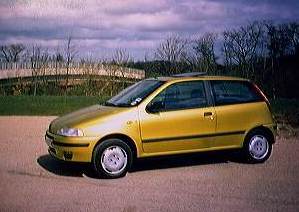
Glowing.
With the allowance now up to 5000 GBP/annum, I could still win with a more expensive car, so the Punto followed. This was bought about 50% for the shape and 50% for the colour, that metallic yellow that was so distinctive, until Nissan started doing Micras in something similar.
Perhaps surprisingly, the yellow Punto was a "waving" car, by which I mean drivers of similar cars wave or flash their lights. This shows that lots of people like me bought it for the colour and were very conscious of it. Other "waving" cars have been the Spitfire; MG Metro (early days); Cinquecento (early days) and especially the Smart.
The Punto was very comfortable, very well equipped, and had a superb engine. This was the 1.2, the second in a range of four engines, and it was flexible, willing and frugal. I had no problems averaging 6.23 litres/100km.
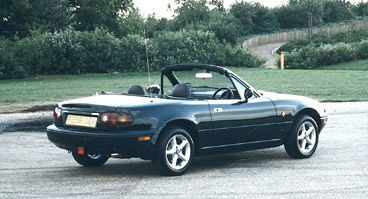
Day 1.
(That costing works out as 28% fuel, 37% servicing, repairs, tax, tyres and insurance, and 35% depreciation. It burnt 12400£ of petrol.)
A complete change, a regression back twenty years, an attempt to re-create the Spitfire age, which was cruelly cut short by the MoT; details. The cost per km was much higher than any other car I've had, despite having 17 years to spread the depreciation over, because of the much lower mileage in its last 12 years and the poor fuel consumption (8.11 L/100km or 35 mi/UKgall).

It fits straight-on too!
I decided to buy a new car for commuting and to keep the MX-5 for playtime. The Smart had the advantages of being cheap, efficient, fun, and short enough (2.5m) to fit onto what was left of our drive behind the Focus. Lots of fun features: a 6-speed automatic or semi-manual gearbox, 3-cyl 600cm3 turbo-charged rear engine, ABS, traction control, glass roof, and left-hand drive.
Unfortunately, it was not trouble-free. The car itself was no less reliable than many, but the dealer chain did not seem to be able to support it. I had a minor shunt in it which cracked the front plastic skin and broke the plastic lugs on the headlamp. Although the repair took only an hour or so to bolt on new parts, these parts took more than four months to arrive. If I hadn't taken it apart myself and improvised some temporary supports from steel strips so that the headlamp could be aimed properly it would have been off the road all this time.
Then the central locking packed up, blowing fuses. It wasn't useable like this, as there were no conventional locks on the doors. After about a week, they'd decided it was probably down to some big and expensive computer box costing 500 GBP. Now the brochure said the warranty was 3 years or 25000 miles, and this car was at 2.5 years and 24987 miles. But the warranty documentation said the limit was 40000km, which is only 24860 miles, so it was not covered, but by special dispensation from Daimler-Chrysler they'd repair for free, but no substitute car. Two weeks later, no word, so I chased again: the computer hadn't fixed it, they'd ordered a whole new wiring loom, which would take weeks to come and days to fit. At five weeks with no news I gave up and sold the car back to them at a disgracefully low price. The Smart dealership was contained within a huge Mercedes Benz place, with common workshops and parts counters, but each with its own separate front door so the customers didn't have to mix; I wonder if the level of service was the same.
Oh, and the transmission was fun too. It wasn't like most automatics with a torque converter and instant-change planetary gears, but an electrically-worked conventional 6-speed box with an electrically-worked conventional dry clutch. It changed gear just like you would, only at its own speed and in its own time. This was usually OK, but a real pain at roundabouts if you didn't quite stop. Typically, as you coasted up to the line, it would be quite happy to stay in 2nd or even 3rd, until you put your foot down to get into a gap, and THEN it decided to change down. Nothing happened until it finished; the engine didn't even rev up because the computer was working the throttle, not you. If you panicked and pushed the pedal right down, it would decide to change down again, so take even longer. Then, seconds later, it would drop the clutch and let the engine fly. And don't think you could get round this by using semi-auto mode. It took the signal from the gearlever as a sort of polite request to change gear if OK by its rules. Sometimes, if you asked it to change down at just the same time as it was deciding you'd left it too late, it would do both your change and one of its own so you went down two gears when you asked for just one.
So it's gone. Pity, it was cute.

First day, sunny and by the canal.
Another cheap car, just small enough to not quite fit on the drive with the Focus, it's tiny, but still a lot bigger than the Smart. And it has three pedals, and a gearlever that does what it's told. And a spare wheel. And simple electrical systems that don't all depend on the computer. It's a Fiat, it will go wrong. But with any luck, any decent mechanic will be able to fix it.
Fiat was about to replace the Seicento with the new Panda and they were clearing their stocks. Somehow this one had done only 80 miles but was registered and nearly a year old.

It's called Guacamole Green.
Bored with the Seicento. Nothing wrong with it, but time for something different. New Panda is not quite basic enough to be a real small Fiat, but it has an interesting tiny (1.25-litre) turbo-diesel engine that promises excellent fuel economy, and it comes in some striking colours.
The Seicento attracted because of its simplicity. The Panda is not simple. The wipers are linked so that the back wiper runs if the front wiper is running and reverse gear is selected. The interior light comes on with the remote central locking and when the ignition key is pulled out, and it fades on and off. The radio can change volume with speed. The accelerator pedal is just an electrical input to the engine computer. All this interlinking is what makes life difficult when something goes wrong, as on the Smart. One can only hope that it keeps on going.
And it did, mostly. It had a couple of dealer visits for intermittent engine warnings caused by a failing fuel temperature sensor, and towards the end the central locking on the tailgate started playing up. But that was all.

Dirty on day 2.
After 100000km the Panda was beginning to feel a bit tired, and as I was still quite happy with it I just replaced it with another one. This one was almost identical except for air-con and MP3 on the CD. It managed to burn only 95% as much fuel as its almost identical predecessor despite being driven as hard as a little Panda can go.
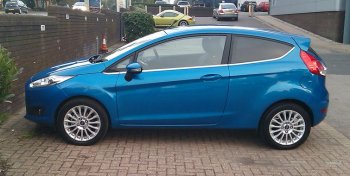
Day one, outside work.
I have bought a Ford at last. These latest Fiestas look interesting, and even smart in the 3-door style. Titanium spec has lots of gadgets, but it was a lot about colour. Switching back now to having just one car each, the Mazda at 17 years old was getting to be more of a project than a plaything and after 8 years the Pandas were getting just a little bit boring.
This was the first car I had with lots of modern electronic things, the Pandas had CAN buses and the like but mostly they behaved like old-fashioned direct-wired cars. This one was full of quirks.
The cruise control was fun. To engage you pressed the ON button followed by either SET+ or RES-. Nothing happened after the first press, not even a beep or warning light, which was unfortunate as the switches didn't always register first time, but after a successful press of each button a warning light did appear. That could just be bad button detection, but once in a while the button functions would switch round, so that RES- would increase the set speed, CAN would reduce it, and SET+ would become the cancel function. That must be a software malfunction. It was quite fond of disabling some of the radio controls too, until the next ignition off/on.
It had a really useful heated windscreen, which worked every time for a few years, then became intermittent, mostly failing on freezing mornings, and then it failed to work at all, along with the rear screen heater. Dr Google suggested that it was trying to save a failing battery by disabling heavy loads, and indeed it was: new battery - all working again. But why not put up a message to say what was going on?
Then there were the secret-handshake functions that you had to find out about, such as how to cancel the service indicator if the garage forgot (pressing pedals in a certain pattern), or how to restore the one-touch-up function on the windows after a battery change (a particular pattern of down and up movements).
It really suffered from lack of use during the Covid-19 lockdowns, needing expensive work to get through the MoT and then various fancy gadgets started playing up, such as the fuel gauge shifting a quarter-tank high before gradually coming back down to correct. It did 600 km in its last year.

Day 2.
A new world, a battery electric car! Lots of gadgets to play with, and that step-less whoosh in response to the right foot. Now with enough range that I should get to work and back easily on <50% charge even in winter. 100 kW motor and 50 kWh battery, but 1500 kg unloaded, of which 326 kg is the battery.
We've gone as electric as possible, we think. Our other car is a plug-in hybrid so for local journeys we are all-electric and for trips where the Zoe doesn't have the range we can still use petrol.
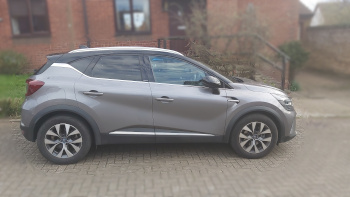
Some grey day at a few years old.
We were going along nicely with one battery electric and one hybrid, but things change, and now with only one driver and an electric that has only slow AC charging and is not suitable for long journeys, I've ended up with both. The Zoe is too nice to get rid of yet so I'm running both until I decide what to do next, probably buy one electric with a decently fast DC charge rate.
The PHEV is fun, but it shows compromises in every way. It's a good petrol car, with excellent fuel economy on a trip, but it's horrendously complicated (see picture below). It's a reasonable short-range city EV except not as quick as most and it has a gear change which slightly spoils the electric smoothness. The boot is smaller than other Capturs with a higher floor to make room for the traction battery. It's pretty quick though with both petrol and electric motors going together. There is a slight hesitation when asked for rapid acceleration if that needs the petrol engine started but no worse than turbo lag.
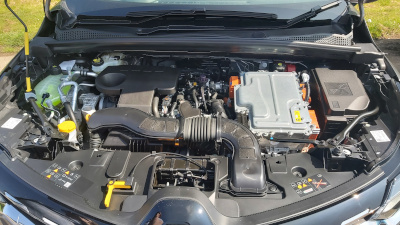
The engine compartment of a PHEV - petrol to the left, electric to the right,
gearbox in between.

It sparkles in the sun.
Down to one car, so the need to have one with DC charging and at a decent rate, but still small. The new Renault 5 is quite striking in appearance and has lots of goodies for not too much money. Had to wait 4 months for it.
This one is really into menus and icons but most of the controls you use while driving are still actual buttons, including the heater and many of the radio functions. For others you can ask Google to do it for you which so far seems a much better voice-activation system than I've seen previously.
Note: cost/km figures include: depreciation, road fund licence, insurance, service, repairs, fuel. They do not include finance costs (I usually "borrow" from myself) and incidental consumables such as cleaning materials. Depreciation is buying price less selling price, and so can be heavily skewed by different dealers either inflating trade-in values or discounting the list price; either way gives the same "cost to change" for the car being purchased, but makes the cost of each individual car more obscure. Cars which were traded-in are shown by a ' after the selling price.| Car | length (m) | width (m) | mass (kg) | kW | kW/tonne | 0-100 km/h (s) | max (km/h) | fuel | L/100km |
|---|---|---|---|---|---|---|---|---|---|
| Morris Minor Traveller 948 | 3.78 | 1.52 | 767 | 26 | 34 | 31 | 121 | 2-star | |
| Triumph Spitfire Mk 2 1147 | 3.68 | 1.44 | 711 | 50 | 70 | 14.8 [d] | 148 | 4-star | |
| Morris Mini van 848 | 3.28 | 1.40 | 620 | 25 | 40 | 116 | 2-star | ||
| BLMC Mini van 1000 | 3.28 | 1.40 | 620 | 29 | 47 | 19 | 2-star | ||
| Austin Allegro 1.5L estate | 3.99 | 1.61 | 928 | 57 | 62 | 151 | 4-star | ||
| MG Metro 1300 | 3.40 | 1.55 | 808 | 54 | 67 | 12 | 161 | 4-star | |
| MG Maestro 1600 | 4.04 | 1.68 | 970 | 77 | 80 | 9.6 | 179 | 4-star | |
| Citroën BX 1.7 RD | 4.24 | 1.65 | 985 | 45 | 46 | 17.2 | 151 | diesel | 5.8 [b] |
| Citroën AXGT 1.4 | 3.50 | 1.59 [a] | 720 | 63 | 88 | 8.8 [d] | 180 | 4-star | 6.8 [b] |
| Fiat Panda 1000 Super | 3.41 | 1.49 | 700 | 34 | 48 | 16 | 140 | unleaded | 6.09 |
| Ford Sierra 5d 1.8GL | 4.42 | 1.70 | 1072 | 67 | 63 | 11.9 | 172 | unleaded | 8.2 [b] |
| Ford Sapphire 1.6L | 4.47 | 1.70 | 1062 | 56 | 53 | 14.9 | 161 | unleaded | 9.0 [b] |
| Rover 214GSi 1.4 | 4.22 | 1.68 [a] | 1065 | 71 | 67 | 11.5 [d] | 171 | unleaded | 7.22 |
| Fiat Cinquecento SX 899 | 3.23 | 1.49 | 710 | 31 | 43 | 18 | 140 | unleaded | 5.58 |
| Fiat Punto 75 ELX 3d 1.2 | 3.77 | 1.63 | 920 | 56 | 61 | 12 | 170 | unleaded | 6.22 |
| Mazda MX-5 1.8i | 3.95 | 1.68 [a] | 990 | 98 | 99 | 8.6 | 197 | unleaded | 8.11 |
| MCC Smart City-Coupé Passion 599 | 2.50 | 1.51 | 720 | 40 | 56 | 17.2 | 136 [e] | unleaded | 5.16 |
| Fiat Seicento 1.1SX | 3.33 | 1.51 | 735 | 40 | 55 | 13.8 | 150 | unleaded | 5.52 |
| Fiat Panda 1.3 Dynamic Multijet #1 | 3.54 | 1.59 [a] | 935 | 51 | 55 | 13 | 159 | diesel | 5.16 |
| Fiat Panda 1.3 Dynamic Multijet #2 | 3.54 | 1.59 [a] | 935 | 51 | 55 | 13 | 159 | diesel | 4.89 |
| Ford Fiesta 1.5TDCi Titanium | 3.97 | 1.71 [a] | 1108 | 55 | 50 | 13.5 | 167 | diesel | 5.31 |
| Renault Zoe GT Line R135 | 4.09 | 1.79 [a] | 1502 | 100 | 67 | 9.5 [d] | 140 [e] | electricity | 18.9 [c] |
| Renault Captur S Edition PHEV | 4.23 | 1.80 [a] | 1564 | 118 | 75 | 10.1 | 173 | petrol/electric | [f] |
| Renault 5 Iconic Comfort | 3.92 | 1.81 [a] | 1455 | 110 | 76 | 7.9 | 150 [e] | electricity | -- [c][b] |
[a] = excluding mirrors
[b] = estimated
[c] = kWh/100km
[d] = 0-60 mi/h
[e] = limiter
[f] = roughly (3.55 L petrol + 8.57 kWh electricity)/100km
[Petrol is about 9.6 kWh/L, diesel about 10.5 kWh/L, so very roughly 5 L/100km is 50 kWh/100km input energy, which at 30% engine efficiency would be 15 kW/100km output, which is what to compare with electric input]
 2025-10-04
2025-10-04